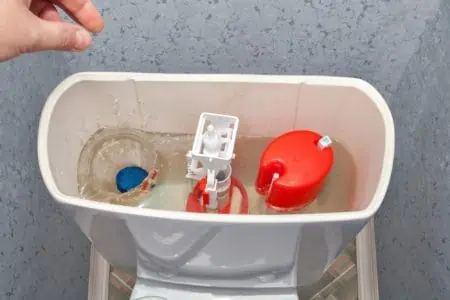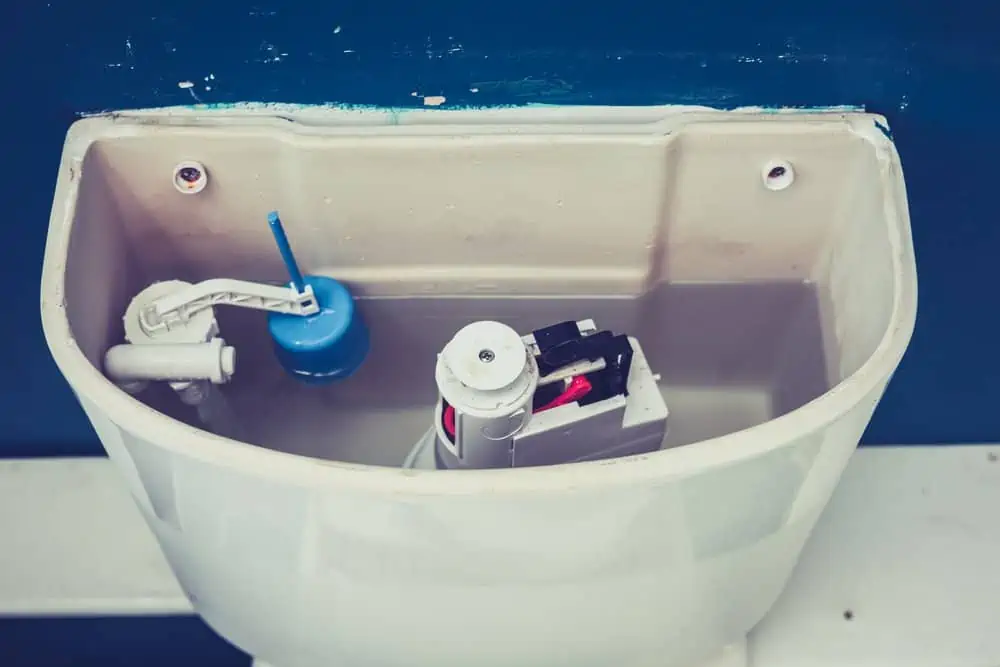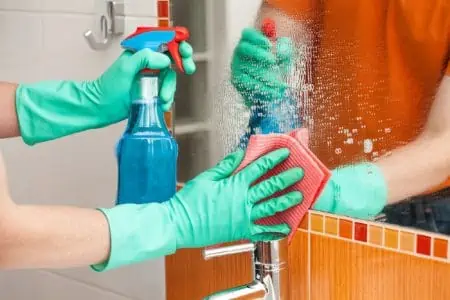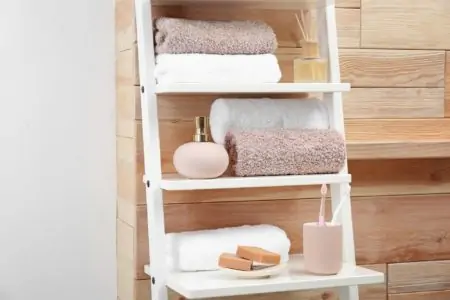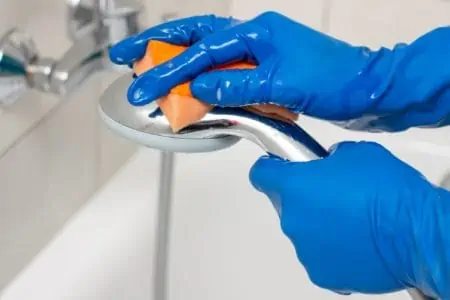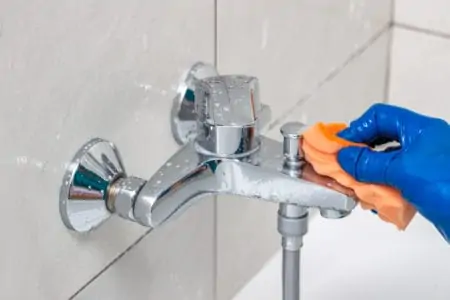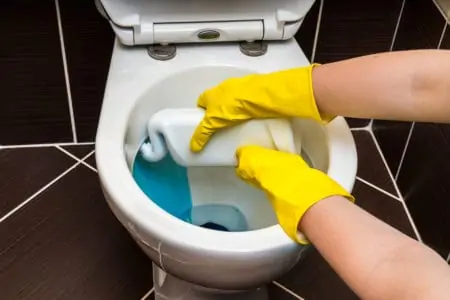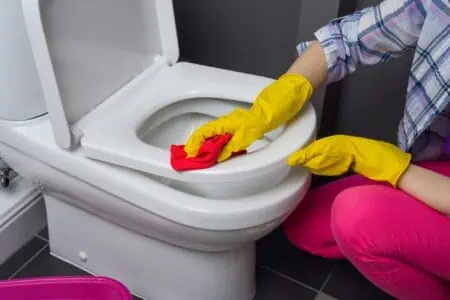Have you ever opened up your toilet tank only to discover that it’s black, slimy, and covered with mold? It’s a disgusting sight. This unsightly mess is a health hazard that needs to be cleaned to prevent the mold, mildew, and bacteria from making your family sick.
So today we’re discussing how to clean a toilet tank to remove the mineral deposits and bacteria lurking in your toilet.
Key Takeaways
- Clean toilet tank twice a year, or more often for hard water or humid areas.
- Use a cleaner specifically made for toilet tanks, like Instant Power Toilet Tank Cleaner.
- Vinegar and baking soda are effective for cleaning toilet tanks, soaking for 12 hours before scrubbing.
- Coca-Cola can be used as an alternative to vinegar to clean toilet tanks, as the phosphoric acid helps remove deposits and kill mold.
How Often Should You Clean a Toilet Tank?
Under normal circumstances, you should clean your toilet tank twice a year if you use the tank regularly. If your water is hard meaning it has a lot of minerals in it, then you should clean your tank quarterly. However, clean your tank monthly if you live in an area that’s extremely humid as the humidity will encourage the growth of mold.
A rarely used toilet tank will need to be cleaned more often as mold and bacteria grow in the standing water.
Cleaning the toilet tank will help prevent the buildup of mineral deposits along the sides of the tank. It will also remove the mold, mildew, and bacteria that could cause illnesses in your family.
Best Toilet Tank Cleaner
Make sure that you use a cleaner made specifically for toilet tank cleaning when you’re shopping for a commercial cleaning product. These cleaners won’t damage the different parts of the tank. Choose a cleaner such as Instant Power Toilet Tank Cleaner.
How to Clean a Toilet Tank Without Draining
It’s recommended that you drain the toilet tank to clean it. However, that’s not always possible or desired. Here’s a quick guide on how to clean your toilet tank without draining it.
- Time: 12-13 hours
- Difficulty: Beginner
What You’ll Need
- 3 gallons distilled white vinegar
- Plastic bristled scrub brush or sponge
- Rubber gloves
- Towel
1. Prep Toilet
Lay a towel on the floor. Put on the rubber gloves, remove the tank’s lid from the toilet, and lay the lid on the towel. This will prevent the porcelain lid from being damaged.
2. Add Vinegar
Don’t drain the toilet. You will pour vinegar into the tank until the water level of the tank is about 1½ inches from the top of the tank.
3. Soak
Let the vinegar and water sit in the tank of your toilet for 12 hours without using it. This will give the vinegar time to dissolve the mineral deposits and kill the mold and bacteria.
4. Scrub
After the tank has soaked for 12 hours, flush the toilet a couple of times to remove the vinegar. Put on your rubber gloves and grab your scrub brush or sponge. Do not use your toilet bowl brush to clean your tank as it’s covered with bacteria that will contaminate your tank.
Carefully scrub the sides and back of your tank and flush the toilet as needed to rinse away the debris.
5. Replace Lid
When the tank is clean, flush the toilet one last time. Pick up the lid and carefully put it back on the tank. It’s ready for use.
How to Clean a Toilet Tank With Vinegar And Baking Soda
Vinegar and baking soda work wonderfully to clean your toilet tank, especially if you drain it first. The first step is to soak the tank with vinegar. The vinegar will help to remove any mineral deposits you may have in your tank.
- Time: 13 hours
- Difficulty: Beginner
What You’ll Need
- Towel
- 7 gallons distilled white vinegar
- Dawn dish soap
- Baking soda
- Sponge or plastic bristle brush
1. Drain Tank
Place a towel on the floor. Remove the lid and place it on the towel. Then turn off the water valve that should be located behind the toilet.
Flush the toilet several times until the tank is empty.
2. Add Vinegar and Soak
This step will help to remove any limestone buildup you have in your tank. If your tank is new or you have soft water that doesn’t include minerals, you can skip this step.
Fill the tank with vinegar up to the overflow tube. You will likely need to add between 3 and 7 gallons of vinegar depending on the size of your tank.
Let the vinegar sit and soak your tank for 12 hours. After 12 hours, flush the toilet to remove the vinegar from the tank.
3. Apply Cleaning Solution
Make a cleaning solution by mixing 2 tablespoons of Dawn dish soap with 1 cup of vinegar and 1⁄2 cup of baking soda. Use a scrub brush and the cleaning solution to scrub your tank. Make sure you get into the nooks and crannies of your tank.
Do not rinse or flush your tank at this time.
4. Wait One Hour
Allow the cleaning solution to sit on your tank for one hour before proceeding.
5. Scrub the Tank
Scrub your tank a second time. This scrubbing will help to remove any loose particles, rust, and stains that the cleaning solution has helped to loosen.
6. Rinse the Tank
Turn on the water intake valve and let the tank fill. Flush the toilet to rinse the tank.
7. Replace Lid
Gently place the lid back on your tank. Your toilet is clean and ready for use.
How to Clean Toilet Tank With Coke
Believe it or not, Coca-Cola can be used as an alternative to vinegar. The phosphoric acid in the coke will help to kill mold and bacteria. In addition, coke will help to remove mineral deposits and rust in your toilet tank and bowl.
Turn off the water intake valve for the toilet and flush it. This will empty the tank.
Next, fill the tank with coke and let the coke sit in the tank for 12 hours or overnight. The next morning, flush the tank to remove the coke and any sediment. Then scrub the tank clean using a sponge or plastic bristle brush.
Turn the water valve on again, let the tank fill, and flush the toilet again to remove any remaining residue from the coke.
How to Clean Toilet Tank Rust
Toilet tanks develop rust as the hardware inside of the tank corrodes and rusts. Here’s how to remove the rust.
- Time: 20-60 minutes
- Difficulty: Beginner
What You’ll Need
- Towel
- Rubber gloves
- Sponge
- Spray bottle
- Scouring powder such as Bar Keepers Friend
- Hydrogen peroxide
- Cream of Tartar
- Vinegar
1. Prep the Tank
Lay a towel on the floor near your toilet. Carefully remove the lid of your tank and place it on the towel.
Next, turn off the water intake valve for your toilet. Flush the toilet several times to drain the tank.
2. Make a Cleaning Paste
Mix equal parts of your scouring powder, hydrogen peroxide, and cream of tartar in a bowl to make a cleaning paste.
3. Scrub Tank
Apply the paste to the rust stains and scrub the stains with a sponge until they are removed. Rinse the tank as soon as you have finished scrubbing the stains with the paste because the hydrogen peroxide may cause the rust to worsen if it’s allowed to sit on the rust for an extended time.
You can easily rinse the tank by getting your sponge soaking wet in the bathroom sink and using the sponge to remove the cleaning paste.
4. Spray Rust with Vinegar
If you have stubborn rust stains, fill a spray bottle with vinegar. Spray the vinegar on the stains and let the vinegar sit on the stains for at least 5 minutes. If needed, you can allow the vinegar to sit for an hour.
5. Scrub the Stains
Use your sponge or a plastic bristle brush to scrub the stains until they’re gone.
6. Rinse
Turn on the water intake valve. Allow the tank to fill and then flush the toilet several times to rinse the vinegar away.
7. Replace the Lid
Carefully put the lid back on the tank. Your toilet is now ready to use again.
Toilet Tank Cleaning Hacks
If you have areas in your tank that are not coming clean, you can try these hacks.
Make a paste of salt, vinegar, and borax. Spread it over any dark stains and let it sit for 12 hours or so. Spray with vinegar to help keep the paste moist. After letting it soak, scrub the area with a scouring sponge or brush and flush the toilet.
Drop several denture tablets into your toilet tank if you’re not able to easily access the tank. The fizzing will help to clean it without scrubbing.
You can use a pumice stone to clean your toilet tank if it’s china. However, don’t use a pumice stone if your toilet is enamel, plastic, or colored.
How to Keep a Toilet Tank Clean
There are a few tricks you can use to keep your toilet tank clean. These hacks will also make cleaning a toilet tank twice a year easier.
- Add toilet cleaning tablets like Vacplus Toilet Bowl Cleaner Tablets to your tank.
- Avoid cleaning a toilet tank with bleach or tablets containing bleach in the toilet tank as the bleach may corrode any metal parts.
- Coat any hardware in your toilet tank with nail polish. This will help prevent them from rusting.
